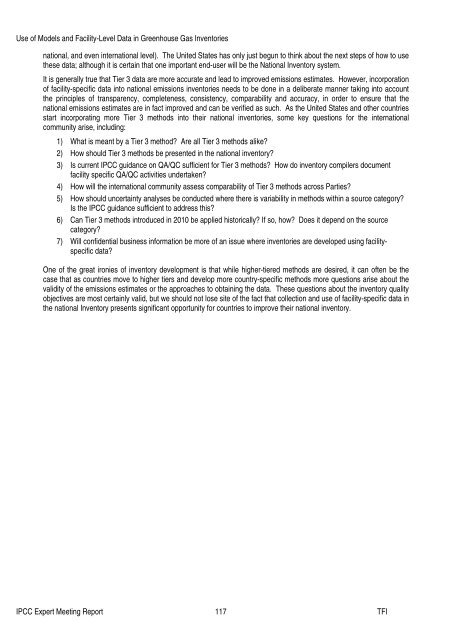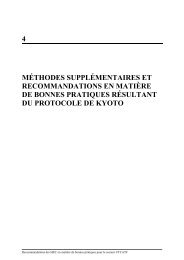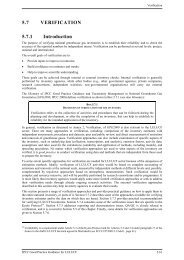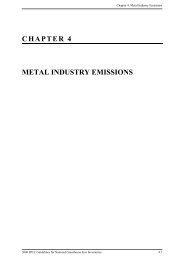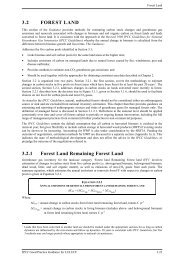Use of Models and Facility-Level Data in Greenhouse Gas Inventories
Use of Models and Facility-Level Data in Greenhouse Gas Inventories
Use of Models and Facility-Level Data in Greenhouse Gas Inventories
You also want an ePaper? Increase the reach of your titles
YUMPU automatically turns print PDFs into web optimized ePapers that Google loves.
<strong>Use</strong> <strong>of</strong> <strong>Models</strong> <strong>and</strong> <strong>Facility</strong>-<strong>Level</strong> <strong>Data</strong> <strong>in</strong> <strong>Greenhouse</strong> <strong>Gas</strong> <strong>Inventories</strong><br />
national, <strong>and</strong> even <strong>in</strong>ternational level). The United States has only just begun to th<strong>in</strong>k about the next steps <strong>of</strong> how to use<br />
these data; although it is certa<strong>in</strong> that one important end-user will be the National Inventory system.<br />
It is generally true that Tier 3 data are more accurate <strong>and</strong> lead to improved emissions estimates. However, <strong>in</strong>corporation<br />
<strong>of</strong> facility-specific data <strong>in</strong>to national emissions <strong>in</strong>ventories needs to be done <strong>in</strong> a deliberate manner tak<strong>in</strong>g <strong>in</strong>to account<br />
the pr<strong>in</strong>ciples <strong>of</strong> transparency, completeness, consistency, comparability <strong>and</strong> accuracy, <strong>in</strong> order to ensure that the<br />
national emissions estimates are <strong>in</strong> fact improved <strong>and</strong> can be verified as such. As the United States <strong>and</strong> other countries<br />
start <strong>in</strong>corporat<strong>in</strong>g more Tier 3 methods <strong>in</strong>to their national <strong>in</strong>ventories, some key questions for the <strong>in</strong>ternational<br />
community arise, <strong>in</strong>clud<strong>in</strong>g:<br />
1) What is meant by a Tier 3 method? Are all Tier 3 methods alike?<br />
2) How should Tier 3 methods be presented <strong>in</strong> the national <strong>in</strong>ventory?<br />
3) Is current IPCC guidance on QA/QC sufficient for Tier 3 methods? How do <strong>in</strong>ventory compilers document<br />
facility specific QA/QC activities undertaken?<br />
4) How will the <strong>in</strong>ternational community assess comparability <strong>of</strong> Tier 3 methods across Parties?<br />
5) How should uncerta<strong>in</strong>ty analyses be conducted where there is variability <strong>in</strong> methods with<strong>in</strong> a source category?<br />
Is the IPCC guidance sufficient to address this?<br />
6) Can Tier 3 methods <strong>in</strong>troduced <strong>in</strong> 2010 be applied historically? If so, how? Does it depend on the source<br />
category?<br />
7) Will confidential bus<strong>in</strong>ess <strong>in</strong>formation be more <strong>of</strong> an issue where <strong>in</strong>ventories are developed us<strong>in</strong>g facilityspecific<br />
data?<br />
One <strong>of</strong> the great ironies <strong>of</strong> <strong>in</strong>ventory development is that while higher-tiered methods are desired, it can <strong>of</strong>ten be the<br />
case that as countries move to higher tiers <strong>and</strong> develop more country-specific methods more questions arise about the<br />
validity <strong>of</strong> the emissions estimates or the approaches to obta<strong>in</strong><strong>in</strong>g the data. These questions about the <strong>in</strong>ventory quality<br />
objectives are most certa<strong>in</strong>ly valid, but we should not lose site <strong>of</strong> the fact that collection <strong>and</strong> use <strong>of</strong> facility-specific data <strong>in</strong><br />
the national Inventory presents significant opportunity for countries to improve their national <strong>in</strong>ventory.<br />
IPCC Expert Meet<strong>in</strong>g Report 117 TFI


